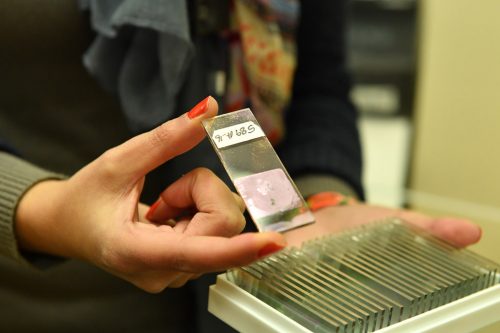There are about 20,000 genes in the human genome that contain the DNA instructions to make everything in the body. Even though all cells contain identical copies of the DNA, each cell expresses different parts of the DNA in different amounts. These varying expression levels allow cells to differentiate into diverse cell types, ranging from brain cells to muscle cells to white blood cells.
Characterizing how baseline gene expression levels vary between tissues has major implications for helping understand the molecular basis for a variety of diseases. Diseased cells have gene expression levels that are vastly different from the baseline expression levels of healthy cells. Knowledge of this differential gene expression can help physicians design more effective treatment regimens that are customized for each patient and disease. Previously, however, there was not a reference database with enough data characterizing baseline gene expression levels across different cell types. To make things even more challenging, different individuals have slight natural variations in baseline expression levels.
Since its launch in 2010, the Genotype-Tissue Expression (GTEx) project has been working to provide such a data resource by collecting and analyzing tissue samples from many different donors. In a recent October 2017 paper published in Nature titled “Genetic effects on gene expression across human tissues,” the GTEx Consortium reports a major expansion to the GTEx project that includes data for 44 (42 distinct) tissue types from more than 7,000 samples gathered from 449 human donors, a huge increase from the 9 tissue types that the GTEx project initially included during its pilot-phase.
To characterize the variation in gene expression levels across different tissues as well as individuals, the GTEx researchers isolated, sequenced, and mapped RNA collected from various tissue samples of different donors. Expressing a gene involves transcribing DNA into RNA. So, by measuring RNA transcript levels for a certain gene in a tissue sample, researchers can determine the level of gene expression in that tissue. High levels of RNA mean that the gene is highly expressed, and low levels of RNA mean that the gene is minimally expressed.
One of the major impacts of the GTEx project has been elucidating how genetic variants affect gene expression on tissues throughout the body. “The Human Genome Project was immensely valuable in allowing us to understand all the individual bases in the genome and to start describing genetic variations present in the human population,” said Stephen Montgomery, a co-corresponding author on the paper and Assistant Professor of Pathology and Genetics at Stanford University. “However, we still have a long way to go in understanding what individual changes in the DNA do on a functional level.”
The GTEx project is one resource helping researchers understand how variations like mutations in the DNA can cause functional changes in gene expression. With the influx of new data, researchers can start making predictions about how these variants might lead to observed effects. Not only does the GTEx project help generate hypotheses, but it also offers a new method of testing them. “[The GTEx Project] provides a large gene expression resource that helps answer all sorts of questions related to gene expression variability across different individuals and tissues,” Montgomery said. “Hopefully this will inspire a next generation of projects that investigate the molecular basis of genetic diseases.”

